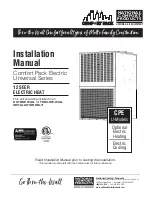
HAPP 40
© 2013 HAPP Australia Pty Ltd
Version 8
36
|
P a g e
floor hoist has a cut out sensor bar that will stop any vehicle hitting the cross
bar. Its height is normally 3.68m, but in this case the maximum lift height of
the hoist will be less than the maximum possible height.
7.
Confirm Ground clearance
for vehicle. HAPP pads will typically install at
around 110-120mm clearance. Whist they can be modified to fit under lower
cars this is typically not the best approach as the pads and lift arms take the
weight of the vehicle and should not be modified. (HAPP considered the
engineering of slimmer arms in this area and decided that it is better to have to
raise some cars rather than compromise standards.) Most customers either
make or purchase vehicle ramps which will raise the vehicle the minimal
amount required to clear the hoist. This is a very simple approach which works
well.
Installation
You will need the following items for hoist installation:
•
ISO grade 46 hydraulic oil Castrol Hyspin 46
•
Two post hoists typically have 20mm anchor bolts. We recommend a trade
quality bit, not the cheap brand. Note, always measure your supplied anchor
bolts before purchasing a concrete bit. The bit should be the size measured
allowing the bolt to neatly fit into the hole.
•
Specialized hammer drill (not a standard hand drill with hammer setting)
•
Socket for anchor bolts / loxon (depending on your model sockets are
typically 24 - 26 24mm)
•
Builders level (for column alignment)
•
Assorted open end spanners for nuts on pump assembly, balance cables,
release cables (single point release models), hose fittings.
•
Read over the installation procedure below before you start to familiarize
yourself with the process.
Installation Procedure
1.
Unpack the hoist
. The hoists are packed head to tail held in a steel shipping
frame. The components to assemble the hoist are mostly pre-assembled,
however some of the parts for assembly are placed inside the columns such
as arms, pads, anchor bolts and hoses. Unpack the contents of the hoist that
can be easily removed, often the arms can be lifted out of the column reducing
the weight of the column for subsequent steps.
2.
Remove the frames
. Support the hoist top that is connected to the top of the
frame (remember the hoist is packed head to tail). Then remove the bolts
holding the frame. Do the same for the other end. Failure to support the
column puts weight on the frame which will likely lead to scratching the hoist
as you remove the frame.
3.
Move the columns apart
and remove the remaining loose pieces from inside
the column.
















































